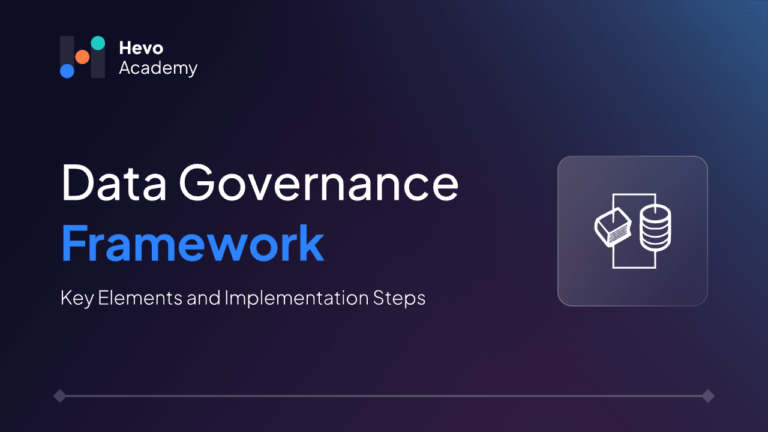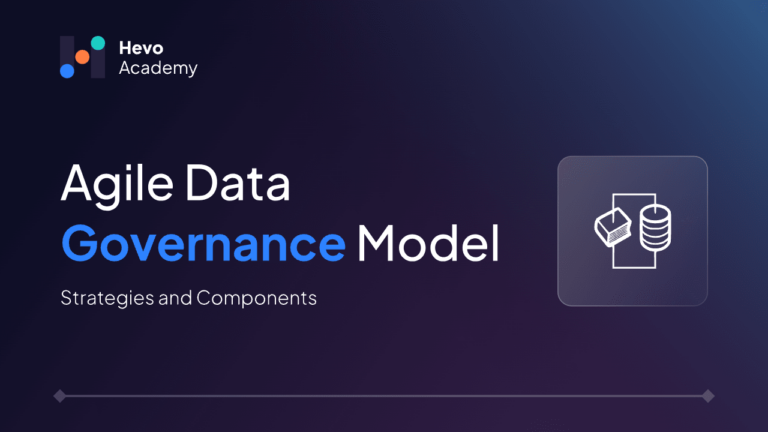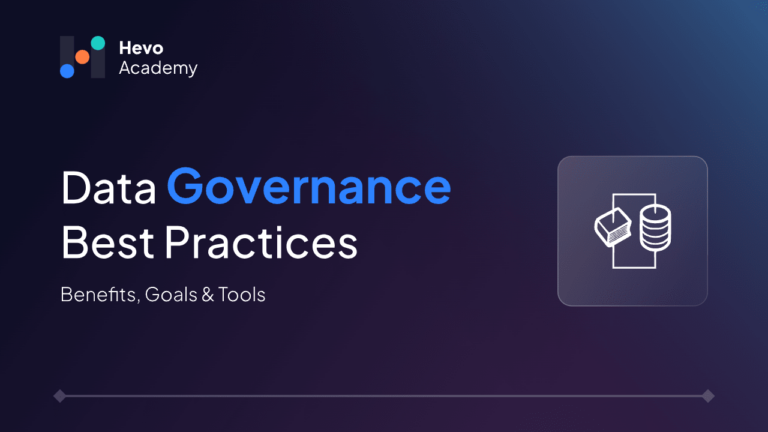As the world’s data needs grow exponentially, data governance policy has become necessary for every data-driven organization because making decisions based on incorrect or irrelevant data can negatively impact your business growth.
Table of Contents
This is where data governance emerges to ensure the data is accurate, safe, and available. This article will explore data governance, why it is essential, and how to implement it. Let’s dive in.
What is a Data Governance Framework?
A data governance framework contains a set of rules and policies to be followed while collecting, storing, and using data. The idea is to protect data from security threats, manual errors, and cyber-attacks throughout its lifecycle.
Key benefits of data governance framework:
- Ensures the data is accurate, consistent, and reliable, enhancing data quality.
- More informed and confident business decisions can be made.
- Compliance with standard data protection regulations, such as GDPR and CCPA.
- Seamless collaboration across teams within an organization.
- Clearly defined roles and responsibilities increase accountability, reducing the risk of human errors.
Hevo’s no-code data integration platform simplifies the implementation of a data governance framework, providing the tools you need to maintain control over your data.
Here’s how Hevo supports your data governance framework:
- Real-Time Data Monitoring: Monitor your data flows in real time, detecting and addressing issues before they impact your operations.
- Centralized Data Management: Integrate data from multiple sources into one unified platform, ensuring consistency and transparency across the organization.
- Automated Data Quality Checks: Implement automated checks and validations throughout your data pipelines to ensure data accuracy, completeness, and reliability.
Take control of your data governance framework and drive better business outcomes with Hevo’s no-code platform. Build a scalable, compliant, and secure data governance strategy with ease.
Get Started with Hevo for FreeWhy Do You Need a Data Governance Framework?
Data governance is crucial for any organization that relies on data for decision-making because data-driven decisions are three times more effective.
Moreover, many companies rely on data for business decisions. Vintage Partners research proves it with a report saying that ~60% of business leaders agree their companies leverage data for business innovation. So, leveraging high-quality data can significantly improve business operations.
A robust data governance policy ensures that data is collected, stored, and accessed based on preset rules, maintaining consistency and accuracy throughout its lifecycle. With clearly defined role-based access controls, the data will be safe in the hands of authorized individuals.
Data governance also plays an essential role in ensuring your data practices align with the standard compliance regulations such as GDPR and CCPA, minimizing risk and privacy violations. Establishing Gartner’s data governance aligned with compliance standards, such as GDPR and CCPA, can help organizations minimize risks associated with data privacy breaches and regulatory fines
To sum up, a data governance framework improves data quality, reduces risk, and complies with privacy policies, resulting in efficient data utilization in your business operations.
5 Key Elements of Data Governance Framework
1. Roles and responsibilities
Clearly define roles and their individual responsibilities. For example, data administrators, stewards, monitors, and consumers should understand their duties and tasks in implementing data governance policy.
2. Data policies and standards
Data rules and policies should be followed while collecting, storing, or analyzing it. These rules contain criteria for accuracy, consistency, reliability, and other key factors that ensure data quality.
So, design clear and relevant data quality policies and standards, effectively communicate them to the respective roles within the organization, and ensure that employees follow them.
3. Data stewardship
Data steward is a specific role that promotes data governance principles across the organization. Their main role lies in executing the data governance plan on a day-to-day basis. This involves solving data-related queries, training employees on governance principles, and handling data access permission requests.
4. Data quality management
Data quality management is the practice of ensuring that data is fit to serve its intended purpose. This mainly depends on five factors: accuracy, consistency, completeness, validity, and timeliness of the data.
5. Data lifecycle management
From creation to disposal, every stage of the data lifecycle should follow predefined data governance rules. These rules ensure the data is secure and consistent during storage, utilization, and modification.
Steps to Implement a Data Governance Framework
Below, we’ve outlined how to implement a data governance framework in your organization.
1. Discover the organization’s needs
Before designing the framework, it’s crucial that you know your organization’s needs and expectations. So, analyze your current data practices and find gaps for improvement. Then, clearly outline the goals and objectives you want to achieve through the governance framework.
2. Develop a strategic data governance plan
Discuss the data governance rules and policies you want to set with the stakeholders, business partners, IT department, and data users to understand their needs and ensure they align with the defined governance plan.
Moreover, the plan should comply with standard data protection regulations, such as GDPR and CCPA.
3. Implement the framework
Now, you have the framework ready to be seen in action. Clearly define each team member’s roles and responsibilities, and ensure they know their duties and use data responsibly.
Leverage software tools and processes to simplify your data governance framework. They automate tasks like quality checks, data catalog management, and role-based access controls to maintain data governance throughout the life cycle.
4. Monitoring and Optimization
This step evaluates if your data governance framework is effective for your organization. It involves regular audits, assessing key performance metrics, and reviewing logs and access controls.
This step also considers identifying areas for improvement, helping in data governance evolution.
You can also explore AI data governance. Check out our blog to see how businesses can implement strong governance frameworks for AI-generated data.
Using a Data Governance Framework Template
Organizations face significant challenges in creating a data governance framework from scratch. Many miss out on considering all key elements of a data governance framework during the process.
That’s where templates come in to simplify the process. Templates are a standard set of predefined data governance frameworks that can be customized to your organization’s needs.
Predefined templates provide a clear structure outlining the necessary components of data governance. This allows you to customize the templates instead of starting from scratch, saving time and effort.
Where To find reliable data governance framework templates?
You can find sample data governance templates on Github or other open-source platforms. For more sophisticated solutions, you can also opt for consulting firms that offer paid services for building data governance frameworks tailored to your organization’s needs.
Publicly available data governance templates: Many government institutes have their data governance framework available online. You can refer to them to create a tailored governance framework for your company. Here are some examples:
- The University of Oklahoma: The institute’s roles, teams, and responsibilities are clearly defined in the template. The framework also contains the data to which the policies are applicable, data discovery management, and guidelines for training employees regarding the framework.
- New Hampshire Department of Education: New Hampshire’s education department has a comprehensive data governance policy with strategy, roles, team responsibilities, and scope—pretty much everything a data governance policy would ever need.
Tools and Technology: Many software tools simplify the data governance framework design process through preset templates, and automates its implementation through their features.
Best Practices for Effective Data Governance
- Incremental approach: Start small by designing a data governance framework for a single domain’s data and scale it to the entire data.
- Be transparent: Ensure your data governance policies are clearly delivered to stakeholders, team members, and data users.
- Monitor KPIs: Define key performance indicators relevant to your objectives and monitor them to validate if your data governance policy is effective.
- Ensure compliance: The data governance framework should align with standard data protection regulations like GDPR, CCPA, and other privacy laws.
- Training: Introduce data literacy and data governance training to the employees to help them understand their responsibilities and duties for implementing it.
Successful data governance requires differentiating between metadata and master data, as each serves a specific purpose in organizing and maintaining data consistency. You can also explore various data governance tools for efficiency.
Take a look at the best practices of Data Governance in detail for effective data management for your organization.
Conclusion
Data governance is the best way to manage data security and integrity. Remember that a strategic and relevant data governance framework is important to harness its full power.
As you embark on this journey, know that every key component you implement in your framework will pay off in the future. The governance framework will not just ensure high-quality data but also save you from huge legal penalties that can occur from sensitive data breaches.
Sign up for a 14-day free trial and experience the feature-rich Hevo suite first hand. Check out the Hevo pricing details.
FAQ
1. What is a framework in data governance?
A data governance framework contains a set of rules and policies that govern how to handle and manage the data.
2. What are the 4 pillars of data governance?
Data quality, data stewardship, data protection and compliance, and data management are the four pillars of data governance.
3. Is GDPR a data governance framework?
No, GDPR is not a data governance framework but a key component of it. It sets guidelines for collecting and using European residents’ personal information.
4. Why is data quality important in data governance?
As business decisions based on high-quality data are intuitive and effective, data quality is a key component in data governance.






